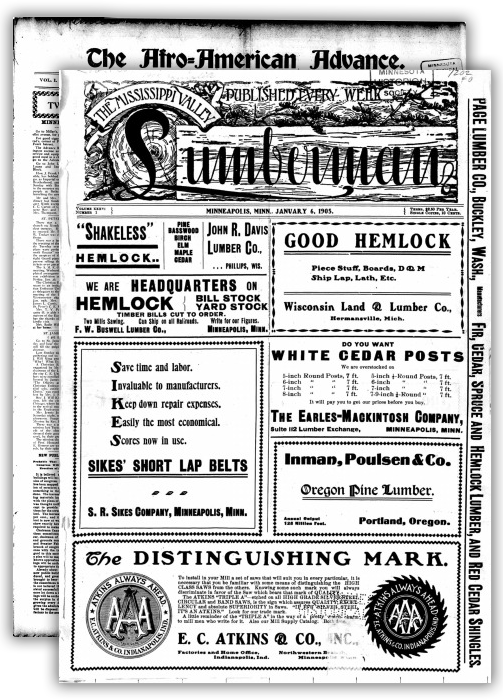
hub
Introduction
titles
About the titles
corporations foundations
Search the Newspapers
hub-faq
F.A.Q.
Choose a Menu
-
hubIntroduction
-
titlesAbout the titles
-
corporations foundationsSearch the Newspapers
-
hub-faqF.A.Q.
International Falls Press
The Koochiching press (International Falls, Minn.) 1904-1905 Browse the title
International Falls press (International Falls, Minn.) 1905-1909 Browse the title
International Falls press and border budget (International Falls, Minn.) 1909-1926 Browse the title
In March 1903, Arthur H. "Bert" Ferrell established the Laurel Press in Laurel, Minnesota. Ferrell moved his equipment to the nearby village of Koochiching (later International Falls) in December 1904, partnered with Charles Willard Stanton, and rebranded the paper as the Koochiching Press on December 21, 1904. Published each Wednesday, the eight-page, six-column paper provided regional, national, and international news in addition to a large literary section of serialized works and short stories. The Koochiching Press also stayed current on events in Rainy River, Ontario, Canada with many of the news items taken verbatim from the Rainy River Press.
On March 22, 1905 the Koochiching Press was renamed as the International Falls Press. The inaugural issue details the formation of the village administration, including Loel H. Slocum as mayor who was also publisher of the Border Budget. It was also determined that the International Falls Press would be the official newspaper of International Falls. The stock "Press Publishing Company" was formed in June 1906 and credited as the paper’s publisher after the Press combined with the Border Budget on June 23, 1909. The new title of the paper became the International Falls Press and Border Budget, which was published on Thursdays. Ferrell withdrew from the company on August 18, 1910, temporarily leaving ownership of the paper to C.W. Stanton. After a brief tenure as editor by George E. Morrison, the paper was sold to George P. Watson, former publisher of the Big Fork Compass. An outspoken character, Watson frequently used the paper as a venue for his political opinions which shifted the normally independent paper to more Republican leanings. Watson’s Prohibitionist sympathies are also considered the impetus for the paper’s facilities being burned down by an alleged arsonist in 1915 when the county decided to officially go "dry".
After George P. Watson took over as editor of the International Falls Press and Border Budget, the content of the paper became more expansive and the tone more casual. National and Minnesota news were supplemented with articles on horticulture, sports, and recipes, as well as a full-page spread detailing a historic event or a scientific topic. However, local content is often diminished with infrequent news reports and personal notices seldom longer than a sentence or two, a stark contrast to the regionally-centered beginnings.
Of particular interest are the coverage of the Koochiching Dam being built from March 1905 to 1910, and the arrival of direct railroads to International Falls in September 1907. Both events were crucial to the then-village’s development into an industrial center and the coverage reflects the ambitions and reservations of the citizens. Later issues of note are the August 18, 1910 issue, which publishes a proposed home charter for the city in full, and the 16-page October 14, 1915 issue, which highlights the output of the city’s various industries. Both issues comprehensively detail how far International Falls had advanced since harnessing its resources only a few years prior. Harlan J. Miner, former manager of the Border Budget, assumed editor and manager duties of the International Falls Press and Border Budget on February 26, 1920 and remained so until the paper changed its name to the International Falls Press on January 7, 1927.
Sources
"Interesting Men Guided First Local Newspapers", "George P. Watson Anniversary Greeting", and "Border Journalism Packed with Romance and Color". International Falls Journal, July 25, 1940.
Hinckley, Ira W. Way back when, an early-day history of International Falls. 1949.
"Anniversary number, the International Falls echo." January 5, 1906.
Minnesota Digital Newspaper Hub
The Minnesota Digital Newspaper Hub is a searchable website from the Minnesota Historical Society that makes millions of pages of Minnesota newspapers available online.
The Hub contains geographically and culturally diverse newspapers published between 1849 and today. Due to potential copyright restrictions most issues published after 1977 can only be accessed from the Gale Family Library at the Minnesota History Center.
The Minnesota Digital Newspaper Hub incorporates Minneapolis Tribune titles previously found on a stand-alone website, foreign-language titles, and much more, with new titles and date ranges continuously being added.
The Minnesota Historical Society's newspaper digitization program is made possible through support from the National Endowment for the Humanities and the National Digital Newspaper Program (NDNP), the Legacy Amendment's Arts and Cultural Heritage Fund through the vote of Minnesotans on Nov. 4, 2008, SELCO (Southeastern Libraries Cooperating) through a grant from the Minnesota Arts and Cultural Heritage Fund for Libraries, and many other organizations and individual donors.
Material in the Digital Newspaper Hub may be protected by copyright law (U.S. Code Title 17).
Looking for more information on MNHS digital newspaper collections? Visit Digital Newspapers at MNHS
